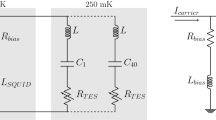Abstract
We describe the design and measurement of feedhorn-coupled, transition-edge sensor (TES) polarimeters with two passbands centered at 220 GHz and 280 GHz, intended for observations of the cosmic microwave background. Each pixel couples polarized light in two linear polarizations by use of a planar orthomode transducer and senses power via four TES bolometers, one for each band in each linear polarization. Previous designs of this detector architecture incorporated passbands from 27 to 220 GHz; we now demonstrate this technology at frequencies up to 315 GHz. Observational passbands are defined with an on-chip diplexer, and Fourier-transform-spectrometer measurements are in excellent agreement with simulations. We find coupling from feedhorn to TES bolometer using a cryogenic, temperature-controlled thermal source. We determine the optical efficiency of our device is \(\eta = 77\%\pm 6\%\) (\(75\%\pm 5\%\)) for 220 (280) GHz, relative to the designed passband shapes. Lastly, we compare two power-termination schemes commonly used in wide-bandwidth millimeter-wave polarimeters and find equal performance in terms of optical efficiency and passband shape.



Similar content being viewed by others
References
Planck Collaboration, et al., arXiv e-prints, arXiv:1807.06209 (2018)
J. McMahon et al., J. Low Temp. Phys. 167(5–6), 879–884 (2012)
A. Suzuki et al., in Society of Photo-Optical Instrumentation Engineers (SPIE) Conference Series, vol 8452 (2012), p. 84523H
A.J. Anderson et al., J. Low Temp. Phys. 193(5–6), 1057–1065 (2018)
S. Dahal et al., J. Low Temp. Phys., This Special Issue (2019). https://doi.org/10.1007/s10909-019-02317-0
S.P. Ho et al., in Society of Photo-Optical Instrumentation Engineers (SPIE) Conference Series, vol 9914 (2017), p. 991418
S.K. Choi et al., J. Low Temp. Phys. 193(3–4), 267–275 (2018)
B.J. Koopman et al., J. Low Temp. Phys. 193(5–6), 1103–1111 (2018)
P. Ade et al., JCAP 2019(2), 056 (2019)
S.M. Duff et al., J. Low Temp. Phys. 184(3–4), 634–641 (2016)
D.T. Chuss et al., J. Low Temp. Phys. 167(5–6), 923–928 (2012)
M.J. Myers et al., Appl. Phys. Lett. 86(11), 114103 (2005)
J. Hubmayr et al., J. Low Temp. Phys. 193(3–4), 633–647 (2018)
S.M. Simon et al., in Society of Photo-Optical Instrumentation Engineers (SPIE) Conference Series, vol 9914 (2016), p 991416
W.B. Doriese et al., J. Low Temp. Phys. 184(1–2), 389–395 (2016)
P.A.R. Ade, G. Pisano, C. Tucker, S. Weaver, vol 6275 (2006), p. 62750U
J. Säily, A.V. Räisänen, Int. J. Infrared Millim. Waves 25(1), 71–88 (2004)
Acknowledgements
This work was supported in part by the NASA APRA program, Grant #NNX17AL23G. This material is based upon work supported by the National Science Foundation Graduate Research Fellowship under Grant No. DGE-1144083. Certain commercial software and materials are identified to specify the experimental study adequately. This does not imply endorsement by NIST nor that the software and materials are the best available for this purpose.
Author information
Authors and Affiliations
Corresponding author
Additional information
Publisher's Note
Springer Nature remains neutral with regard to jurisdictional claims in published maps and institutional affiliations.
Rights and permissions
About this article
Cite this article
Walker, S., Sierra, C.E., Austermann, J.E. et al. Demonstration of 220/280 GHz Multichroic Feedhorn-Coupled TES Polarimeter. J Low Temp Phys 199, 891–897 (2020). https://doi.org/10.1007/s10909-019-02316-1
Received:
Accepted:
Published:
Issue Date:
DOI: https://doi.org/10.1007/s10909-019-02316-1




